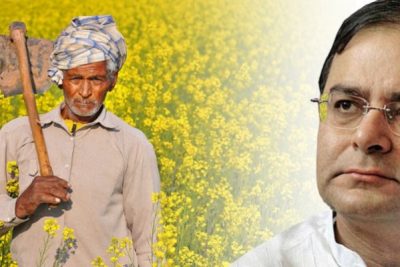Good that with a strong Budgetary focus on farmers and rural welfare, the government may have initiated a much needed course correction. After all, growth must be inclusive in order to be sustainable. An eye also on the state elections maybe, as analysts point out, but full marks to Arun Jaitley nevertheless for listening to the average farmer's “mann ki baat.”

The stock market responded in a zig-zag fashion during the course of the Budget presentation but finally happened to end up flat. Often, governments tend to give too much importance to the movements at the bourses but perhaps it’s time for our policy makers to realize that the country can live with some of these zigzags. After all, the growth of the economy is not directly proportional to the growth of the Sensex! Why, then, should the government go out of its way to appease the market?
This is certainly not to say that the government needs to be against the industry—it anyways is not. The organized sectors in the industry too, however, on their part need to realize that along with the government sector, they employ just about seven percent of the workforce and that over 50 percent of the population still depends on the agriculture for sustenance. The remaining workforce is employed by the unorganized sectors.

Even more important is to always remember the fact that India still has a pyramidal socio-economic structure, unlike some of the developed countries that may have prism-like structures or some of the highly developed nations where the structure may resemble the shape of an inverted pyramid.
India’s socio-economic structure means that most of its population lies at the bottom of the pyramid and is even highly marginalized and only a small part of the population is at the top of the pyramid and may be termed as extremely affluent when compared with those lying at the bottom of the structure. (The middle classes are in the middle)
The fact is that the
stability of India’s socio-economic pyramid lies in the stability of its bottom parts and no economic policy or annual budget that ignores this fundamental fact could ever, ever sustain and succeed.
With the Budget presented for the 2016-17 fiscal, Finance Minister has recognized this fact well enough, as he announced an outlay of Rs 35,984 crore aimed at improving situations of farmers and improving productivity. An early impression also shows that plans are aimed at empowering farmers in the long run, even if there may be interim measures to address the immediate concerns. This is a good thing and it would be important for the government to ensure that it doesn’t get lured into taking only populist measures that are aimed at short-term appeasements only.
As for the rest of the socio-economic groups, the
Budget seems to have a pyramidal flavor to it, as the FM announced some sops for the middle income groups too. These came in the form of proposals such as additional exemption for housing loans of up to Rs 35 lakh and increase in HRA deduction to Rs 60,000 per annum. On the other hand, the Budget sent out signals that the even higher income groups may have to pay more, such as in the form of an additional 10 percent tax on dividend income.
As for the industry and the stock markets at large, there seems to be a mixed bag. A negative may be the rise in service tax from 14.50 percent to 15 percent. On the other hand, there may be a big and long-awaited relief as the introduction of a retrospective tax has been ruled out.




